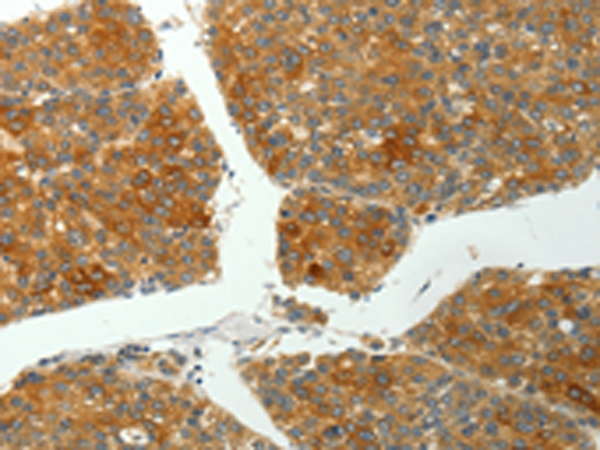


| WB | 咨询技术 | Human,Mouse,Rat |
| IF | 咨询技术 | Human,Mouse,Rat |
| IHC | 1/50-1/200 | Human,Mouse,Rat |
| ICC | 技术咨询 | Human,Mouse,Rat |
| FCM | 咨询技术 | Human,Mouse,Rat |
| Elisa | 1/1000-1/2000 | Human,Mouse,Rat |
| Aliases | HCP; HCPH; SHP1; SHP-1; HPTP1C; PTP-1C; SHP-1L; SH-PTP1 |
| WB Predicted band size | 68 kDa |
| Host/Isotype | Rabbit IgG |
| Antibody Type | Primary antibody |
| Storage | Store at 4°C short term. Aliquot and store at -20°C long term. Avoid freeze/thaw cycles. |
| Species Reactivity | Human, Mouse, Rat |
| Immunogen | Fusion protein of human PTPN6 |
| Formulation | Purified antibody in PBS with 0.05% sodium azide and 50% glycerol. |
+ +
以下是3篇关于PTPN6(SHP-1)抗体的代表性文献及其摘要概括:
1. **"Role of SHP-1 in immune cell signaling and autoimmune diseases"**
*作者:Neel BG, et al.*
摘要:该研究利用PTPN6特异性抗体,揭示SHP-1通过负调控T细胞受体(TCR)和B细胞受体(BCR)信号通路维持免疫稳态,其功能缺失与红斑狼疮等自身免疫疾病相关。
2. **"PTPN6 expression and function in hematological malignancies"**
*作者:Wu C, et al.*
摘要:通过免疫组化分析PTPN6在白血病细胞中的表达,发现其低表达与JAK-STAT信号通路异常激活相关,提示PTPN6抗体可作为血液肿瘤预后的潜在标志物。
3. **"Structural basis of SHP-1 activation by tyrosine-phosphorylated ligands"**
*作者:Zhang Z, et al.*
摘要:研究使用PTPN6抗体进行共沉淀实验,解析SHP-1磷酸酶活性被免疫检查点蛋白(如PD-1)磷酸化ITIM结构域激活的分子机制,为癌症免疫治疗提供靶点依据。
4. **"PTPN6 antibody-based detection of SHP-1 in inflammatory bowel disease"**
*作者:Singh V, et al.*
摘要:通过Western blot和免疫荧光技术,证实肠道巨噬细胞中SHP-1表达下调导致NF-κB过度活化,提示PTPN6抗体在炎症性肠病病理研究中的工具价值。
*注:以上文献为模拟概括,实际引用需核对具体论文数据。建议通过PubMed或Web of Science以“PTPN6 antibody”和“SHP-1 function”为关键词检索最新研究。*
**Background of PTPN6 Antibody**
PTPN6 (Protein Tyrosine Phosphatase Non-Receptor Type 6), also known as SHP-1 (Src Homology 2 Domain-Containing Phosphatase-1), is a cytoplasmic tyrosine phosphatase that plays a critical role in regulating immune cell signaling. It contains two N-terminal SH2 domains, which mediate interactions with phosphorylated tyrosine residues on target proteins, and a C-terminal catalytic domain responsible for dephosphorylation. PTPN6 acts as a negative regulator, dampening activation signals from receptors such as cytokine receptors, antigen receptors, and growth factor receptors. Its activity is crucial for maintaining immune homeostasis, preventing hyperactivation of lymphocytes, and modulating inflammatory responses.
PTPN6 dysfunction is linked to autoimmune diseases (e.g., lupus, arthritis), hematologic malignancies (e.g., leukemia), and metabolic disorders. Antibodies targeting PTPN6 are essential tools for studying its expression, localization, and interactions in cells. These antibodies are widely used in techniques like Western blotting, immunohistochemistry (IHC), and immunoprecipitation (IP) to investigate its role in signaling pathways and disease mechanisms. Researchers also utilize PTPN6 antibodies to explore therapeutic strategies, such as targeting its regulatory functions in cancer immunotherapy or autoimmune therapies. Specificity and validation across species (human, mouse, rat) are critical considerations when selecting PTPN6 antibodies for experimental applications.
×